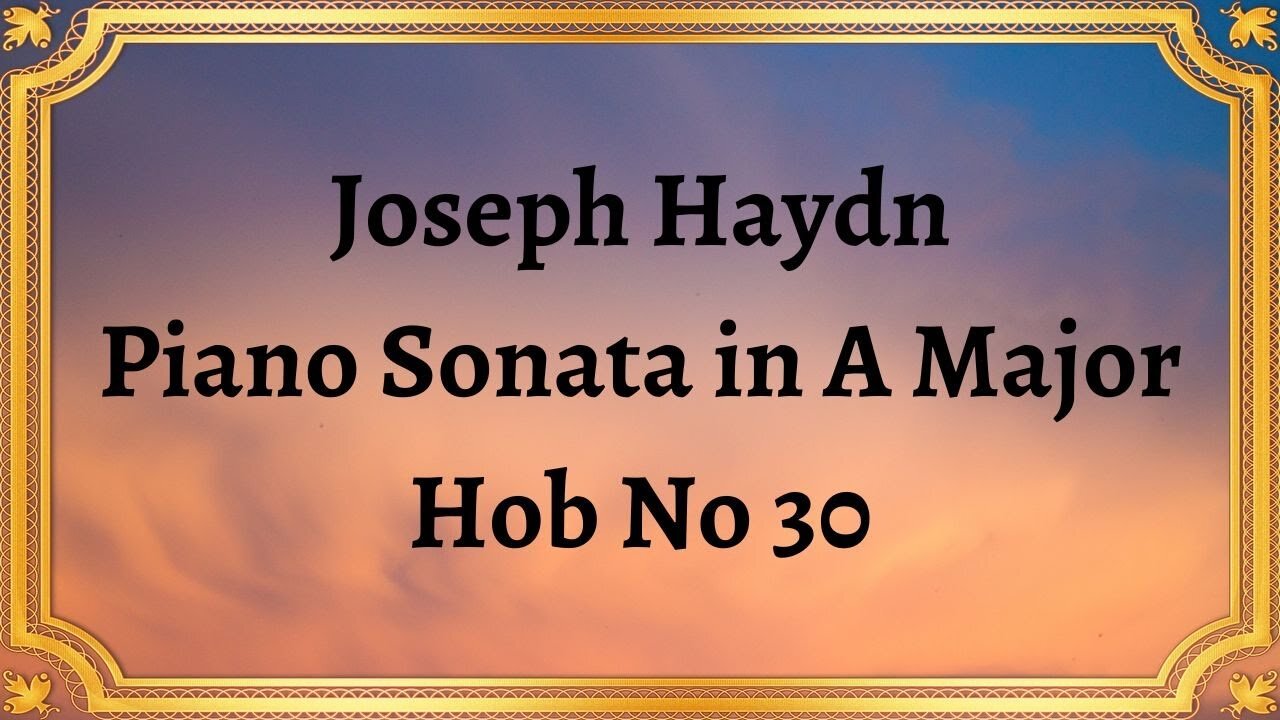Premium Only Content

Joseph Haydn Piano Sonata in A Major Hob No 30
#JosephHaydn #PianoSonata #AMajor #HobNo30 #classicalmusic #musiccomposition #melody #structure #emotionaldepth #harmonicchanges #musicform #virtuosity #humor #playfulness #Scherzo #PrestissimoFinale #musicanalysis #musictheory #musicappreciation #musiceducation #musicperformance #musicology #musichistory
Joseph Haydn's Piano Sonata in A Major, Hob No. 30 is a wonderful example of a classical-era piano composition. This masterpiece is part of a set of six piano sonatas he wrote between 1784 and 1785. The A Major sonata is the fifth of the set, and it has become one of the most popular piano sonatas written by Joseph Haydn.
The Piano Sonata in A Major is comprised of three movements: Moderato, Scherzo, and Adagio, followed by a Prestissimo Finale. In the first movement, Haydn demonstrates his mastery of melody and structure through the use of a simple yet captivating melody which is explored and developed over the course of the movement. The second movement, Scherzo, is notable for its use of syncopated rhythms, which gives the music a playful and rhythmic quality.
The third movement, Adagio, is characterized by its emotional depth and expressiveness, with its melancholic melodies and darker harmonies. This movement showcases Haydn's exceptional ability to convey deep emotional content through his music. The final movement, Prestissimo Finale, concludes the sonata with an exciting and virtuosic display of Haydn's musical skill.
The Piano Sonata in A Major is a technical and musical challenge for any pianist. The piece requires a high level of technical proficiency, with virtuosic scales and runs, precise articulation, and rapid shifts in mood and dynamics. Additionally, the sonata requires great musical sensitivity, with its complex and nuanced dynamic and harmonic changes.
Haydn was a master of musical form, and this sonata is an excellent example of his skill in this area. The piece adheres to the classical sonata form, with its distinctive structure of exposition, development, and recapitulation.
The Piano Sonata in A Major is also noteworthy for its use of humor, playfulness, and joy, which reflect Haydn's charming and witty personality. This playful tone is present throughout the piece, from the Scherzo's syncopated rhythms to the Prestissimo Finale's lively melodies.
In conclusion, Joseph Haydn's Piano Sonata in A Major, Hob No. 30 is a masterpiece of classical-era piano music. It showcases Haydn's extraordinary musical skill and creativity, as well as his remarkable ability to convey deep emotions through his music. The Piano Sonata in A Major remains one of the most beloved and frequently performed pieces in the classical piano repertoire.
You have the opportunity to support the channel https://destream.net/live/RadSiarAl/donate
-
 1:58:31
1:58:31
The Dilley Show
2 hours agoTrump Conquering Western Hemisphere? w/Author Brenden Dilley 12/23/2024
40.9K6 -
 1:09:59
1:09:59
Geeks + Gamers
3 hours agoSonic 3 DESTROYS Mufasa And Disney, Naughty Dog Actress SLAMS Gamers Over Intergalactic
18.8K2 -
 51:59
51:59
The Dan Bongino Show
4 hours agoDemocrat Donor Admits The Scary Truth (Ep. 2393) - 12/23/2024
496K1.42K -
 2:32:15
2:32:15
Matt Kohrs
15 hours agoRumble CEO Chris Pavlovski Talks $775M Tether Partnership || The MK Show
83.5K24 -
 28:23
28:23
Dave Portnoy
15 hours agoDavey Day Trader Presented by Kraken - December 23, 2024
98K32 -
 59:29
59:29
BonginoReport
6 hours agoTrump, Murder Plots, and the Christmas Miracle: Evita + Jack Posobiec (Ep.110) - 12/23/2024
111K92 -
 2:59:14
2:59:14
Wendy Bell Radio
9 hours agoNothing To See Here
97.4K57 -
 2:12:18
2:12:18
TheDozenPodcast
1 day agoIslam vs Christianity: Bob of Speakers' Corner
93.9K23 -
 14:36
14:36
The StoneZONE with Roger Stone
1 day agoRoger Stone Delivers Riveting Speech at Turning Point’s AMFEST 2024 | FULL SPEECH
116K27 -
 18:59
18:59
Fit'n Fire
15 hours ago $7.16 earnedZenith ZF5 The Best MP5 Clone available
78.4K3